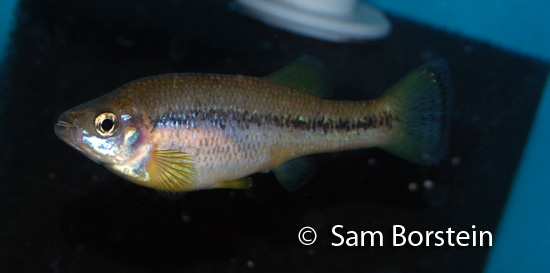Ilyodon furcidens
(Jordan & Gilbert, 1883)
Bass Goodeid, Goldbreast Splitfin

Above: A male Goldbreast Goodeid. Photo by Sam Borstein.
Etymology:
Genus- Ilyodon= Ilyos= cave (Greek), odus= tooth (Greek) .
Species- furcidens= forked tooth (Greek).
Intro:
Ilyodon furcidens is a robust livebearer from Mexico and one that is rather pugnacious. Although not the most common goodeid in the hobby, Ilyodon furcidens is a wonderful livebearer to keep with larger Central Americans as they can hold their own quite well.
Ilyodon furcidens has two common names in the hobby, both in reference to its color. Ilyodon furcidens does get a very nice brassy-yellow breast, leading to the common name Goldbreast Splitfin. It also has a similar color pattern to a Largemouth Bass, leading to the trade name Bass Goodeid.
Distribution:
The Bass Goodeid is endemic to Mexico and can be found in riffles of cool water rivers in the Ameca, Armeria, and Cihuatlan river basins.
Size, Maturity, and Sexual Dimorphism:
Size: Males- 4.5 inches, Females- 6 inches
Maturity: 3 inches
Sexual Dimorphism: Males are smaller than females also possess and andropodium, which is a modified anal fin for reproduction. This is seen as a notch in the male’s anal fin.

Above: A female Ilyodon furcidens. Photo by Sam Borstein.
Care:
Bass Goodeids are easy to care for. This is a robust goodeid and one that is relatively aggressive. I'd recommend no tank smaller than a 40 breeder for a group of five. They mix well with larger, somewhat more aggressive cichlids. It is important to note that they will nip fins, so it's not best to keep them with cichlids that have trailers. This goodeid seems to thrive in cool water. I've had them develop some skin and scale issues at temperature above 76 °F. Ideally, this species is best kept around 72-74 °F.
Diet:
Bass Goodeids are omnivorous in the wild and will eat anything in aquarium. They predominantly feed on vegetable matter and insects in the wild. A mixed flake and pellet will serve this fish well as far as diet is concerned. It is a hearty fish and can eat quite a lot.
There are two morphs of this fish in the wild, a narrow and broad mouted form. Both these fish feed upon algae, with narrow mouthed form also feeding at the surface. These fish were described as separate species by Kingston in 1979 as Ilyodon furcidens for the narrow mouthed form and Ilyodon xantusi for the broad mouthed form (Miller, 2005). It has been debated whether there really are two species or not. If they are shown to be synonyms, they will be called Ilyodon furcidens as it is the oldest available name.
Breeding:
Ilyodon furcidens breeds like most goodeids. This species has a very long gestation period of nearly two months. It's important to note that goodeids don't store sperm like other livebearers and need to spawn for each brood.
The fry are huge when born, about .75 inches long! Spawns can range from 5-50 per brood, 50 being from a larger female. The fry hang at the top of the tank for their first week out of the womb. I highly recommend placing lots of floating plants in the tank as refuge for the fish as I've found the adults will actively pursue the fry and harass them. I've found the best thing to do is remove fry to a rearing tank once you see them in the tank with the adults. The fry are very easy to raise and will feed right away on crushed flake. The fry grow quickly and look just like females in terms of coloration.
Conclusion:
Ilyodon furcidens is a nice livebearer to keep, but due to it being large and rather aggressive, probably will never be very popular in the hobby. This fish is available from livebearer enthusiasts and although not common, usually is quite affordable.
References:
- Miller, R.R., Minckley, W.L. & Norris, S.M. (2005) Freshwater Fishes of México. Museum of Zoology, University of Michigan, & University of Chicago Press, Chicago, 652 pp.
